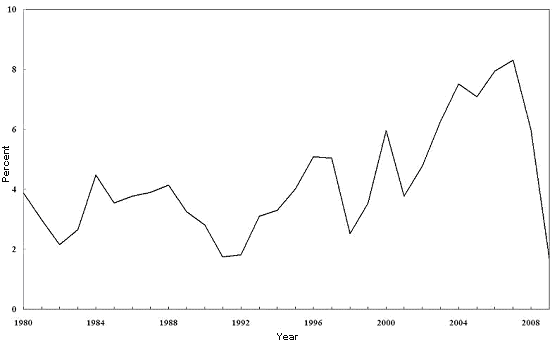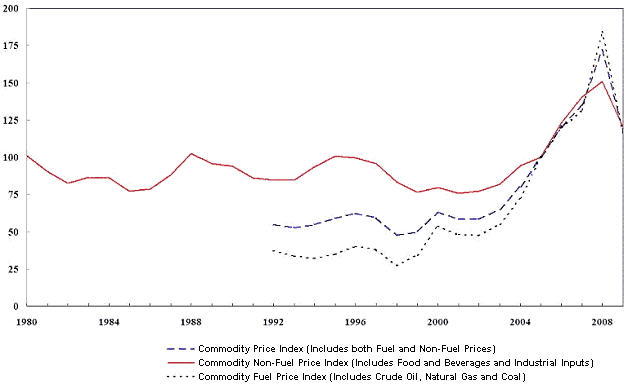ESTUDIOS Y AN罫ISIS
Commodity terms of trade: The history of booms and busts(1)
Nikola Spatafora (Senior Economist) and Irina Tytell (Economist), Research Department, The International Monetary Fund
(solamente en ingl閟)
How do commodity-price booms affect the economic performance of
commodity exporters? This column presents comprehensive new data on
country-specific commodity terms of trade. It finds that, on average,
countries grow nearly 2 percentage points faster during booms than
during busts. But policy plays an important role ?sharp currency
appreciations and large government deficits are associated with lower
growth.
How commodity prices affect the macroeconomic performance of
commodity-exporting countries ?particularly developing countries ?has
long been the subject of heated debate. Some studies find that commodity
booms raise growth, while others suggest a 搑esource curse?that
undercuts sustainable growth.
In recent years, this debate has regained momentum. As shown in Figures
1 and 2, the rapid growth observed in many developing countries from the
start of the 2000s until the beginning of the current financial crisis
coincided with a sharp increase in commodity prices.
Until the turn of the 21st century, commodity prices had been in general
decline for some decades. During mid-2008, commodity prices rose by
about 75% in real terms on average. By historical standards, this latest
commodity boom was broad-based and sustained, with the prices of most
commodities rising sharply (especially energy and industrial inputs,
including agricultural raw materials and metals, but also major food
crops and some beverages). After the financial crisis erupted, commodity
prices fell rapidly, and they have since remained very volatile. It
remains to be seen to what extent strong commodity price pressures
re-emerge as the global economy recovers.
Figure 1. GDP growth: Emerging and developing economies
Figure 2. Commodity prices indices (2005=100)
New evidence on the effect of commodity-price booms
Figures 1 and 2 raise two crucial questions. First, looking back, to what extent was the growth acceleration in developing countries a by-product of the commodity boom?
Second, and related, how will developing countries?future growth
trajectories depend on the outlook for commodity prices?
Unfortunately, existing analyses of commodity booms generally rely on
unsatisfactory price data, either a country抯 aggregate terms of trade,
or else simply the price of one or two key commodity exports.
In a recent IMF Working Paper (Spatafora and Tytell 2009), we use the
first comprehensive dataset on country-specific commodity terms of
trade. While Deaton and Miller (2006) and Cashin et al (2004) construct
country-specific commodity export prices in a similar way, the
terms-of-trade measure used in our study takes into account both
commodity export and import prices. Moreover, our study adjusts for the
importance of commodities in overall trade of each country.
Our study identifies country-specific commodity-price cycles. It dates
and characterises commodity booms and busts for a sample of more than
150 countries over nearly 40 years starting in the early 1970s.
Additionally, we begin the task of harvesting this dataset to analyse
the link between commodity-price cycles and macroeconomic performance,
how this link depends on various policy variables, and whether the
experience of the past few years suggests a significant break with
previous historical patterns.
Frequent booms and small busts
Some of our key initial findings are as follows. Regarding the nature of
commodity-price movements, commodity-price booms tend to be larger than
busts. On a cautionary note, however, around 1/3 of all booms are
followed by busts (and, likewise, around 1/3 of all busts are followed
by booms). Further, the larger the boom, the larger the subsequent bust.
Turning to the impact of commodity-price booms, we find that median
output growth is nearly 2 percentage points per annum higher during
booms than during busts. That being said, policy plays an important role
in determining the response to booms. In particular, during both booms
and busts, large real currency appreciations are associated with
significantly lower growth. Also, the larger the pre-boom government
deficit, the smaller the growth during the subsequent boom. One
interpretation is that larger initial deficits increase the potential
for crowding-out of private spending.
Finally, it appears that higher growth during the latest commodity-price
cycle was at least partly due to non-global factors. Rather, it
reflected factors specific to those countries that experienced a
commodity terms-of-trade boom. Such factors included smaller real
currency appreciations than in the past, as well as better initial
conditions 杋ncluding stronger initial fiscal positions in particular.
Put differently, improved policy frameworks and policy responses helped
countries benefit from improved terms of trade to a greater extent than
in the past. This gives grounds for optimism looking ahead. Still, the
commodity booms of the 2000s were also, on average, quite long and, in
particular, lasted longer than in the past ?a pattern that may not be
repeated in the future.
References
Cashin, Paul, Luis F Cespedes, and Ratna Sahay (2004), 揅ommodity
Currencies and the Real Exchange Rate? Journal of Development
Economics, 75:239-268.
Deaton, Angus, and Ronald Miller (1996), 揑nternational Commodity
Prices, Macroeconomic Performance, and Politics in Sub-Saharan Africa?
Journal of African Economies,5:99-191.
Spatafora, Nikola and Irina Tytell (2009), 揅ommodity terms of trade:
The History of booms and busts? IMF Working Paper 09205, September.
Nota:
1. from
VoxEU.org.
back to text

